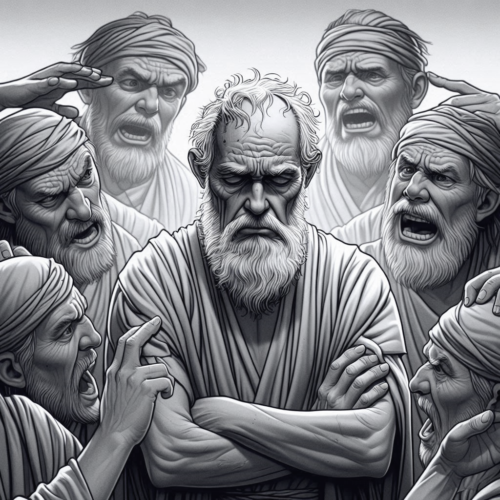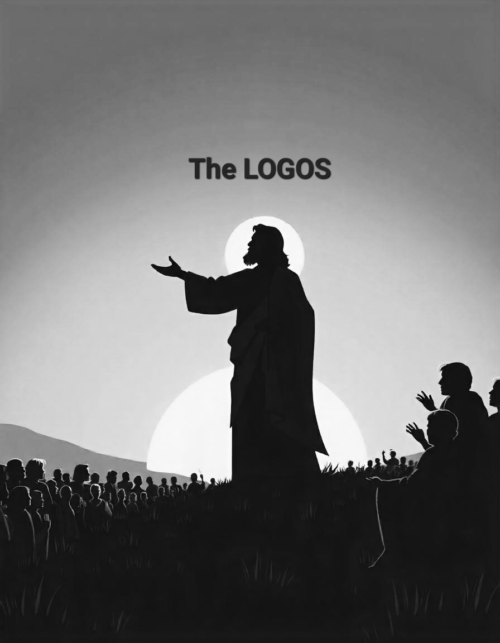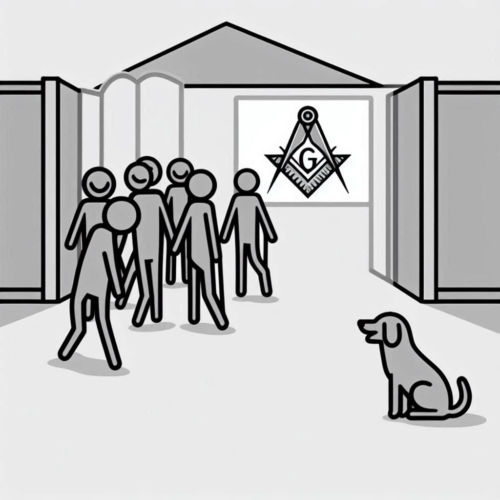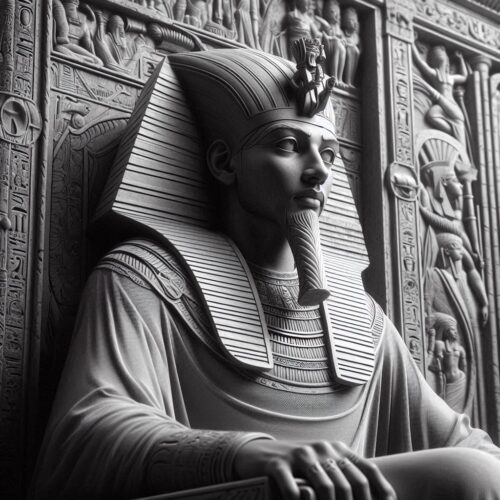What Did the Inscription on Jesus’ Cross Really Say?
A REFORMED RESPONSE TO CLAIMS OF GOSPEL CONTRADICTIONS
Sceptics love to point out what they see as a glaring contradiction in the gospel accounts. When describing Pilate’s inscription above Jesus’ cross, the four evangelists seem to tell different stories:
- Matthew 27:37: “This is Jesus, the King of the Jews”
- Mark 15:26: “The King of the Jews”
- Luke 23:38: “This is the King of the Jews”
- John 19:19: “Jesus of Nazareth, the King of the Jews”
“If the gospel writers can’t even agree on a simple sign,” critics argue, “how can we trust anything they tell us about Jesus?”
But here’s the thing: these apparent differences actually strengthen rather than weaken the gospel accounts. Let’s see why.
THE HEART OF THE MATTER
First, notice what the gospels agree on: the central accusation was “the King of the Jews.” This was the political charge that got Jesus crucified. Not one evangelist disputes the core fact.
The variations come in the additional details—whether the sign included “This is,” “Jesus,” or “of Nazareth.” These aren’t contradictions; they’re complementary accounts that together give us the fullest picture of what was written.
WHY THE DIFFERENCES MAKE PERFECT SENSE
Multiple Languages, Multiple Versions: John explicitly tells us Pilate’s inscription was written in three languages: Hebrew, Latin, and Greek (John 19:20). This detail is crucial. Each gospel may be preserving a different language version of the same sign.
Think about it: if you were translating an official notice into three different languages, would each version be word-for-word identical? Of course not. The core message would remain the same, but the specific wording may vary slightly based on each language’s structure and idioms.
Different Authors, Different Emphases: Each evangelist wrote for a specific audience with particular concerns:
- Matthew includes “This is Jesus” because he’s writing primarily to Jewish readers who need to understand that this specific person, Jesus, was being identified as their supposed king.
- Mark, known for his concise style throughout his gospel, gives us the briefest version—just the essential legal charge.
- John provides the most complete version, “Jesus of Nazareth, the King of the Jews,” fitting his pattern of giving detailed accounts of Jesus’ passion.
These aren’t mistakes; they’re purposeful selections that serve each author’s theological goals while remaining completely truthful.
Ancient Writing Standards: Here’s something many modern readers miss: ancient historians didn’t quote with the same precision we expect today. They regularly summarised and paraphrased while maintaining the essential meaning. Capturing the gist was more important than preserving every single word.
When Josephus, Tacitus, or other ancient writers recorded speeches or inscriptions, they focused on conveying the accurate sense rather than providing transcript-level precision. The gospel writers were working within these same literary conventions.
WHY THIS ACTUALLY PROVES THE GOSPELS’ RELIABILITY
Evidence Against Conspiracy
If the gospels were fabricated or if the authors had coordinated their stories, wouldn’t they have made sure their accounts matched perfectly? The fact that they vary in minor details while agreeing completely on the central facts is exactly what we’d expect from independent, truthful witnesses.
Think about how this works in real life. If four people witness a car accident and later give testimony, their accounts will agree on the major facts—what happened, when, and to whom—but they’ll differ on smaller details based on where they were standing, what caught their attention, and how they remember the event. Perfect verbal agreement would actually be suspicious.
Multiple Attestation
The core message of Pilate’s inscription is confirmed by four independent sources. This is the historical principle of multiple attestation—when multiple independent witnesses agree on essential facts, it dramatically increases our confidence in those facts.
The variations in peripheral details don’t weaken this principle; they strengthen it by showing that the witnesses weren’t simply copying from each other.
THE BIGGER PICTURE
Pilate intended his inscription as mockery. He was essentially saying, “Look at your pathetic king, you Jews.” But in God’s providence, Pilate’s sarcasm became prophetic proclamation. Jesus truly was and is the King of the Jews—and much more.
Whether the sign read “This is Jesus, the King of the Jews” or “Jesus of Nazareth, the King of the Jews,” the truth it proclaimed remains unchanged. The slight variations in how the evangelists recorded it don’t diminish the thunderous agreement on the central reality: this crucified man was being charged with claiming to be Israel’s king.
And the beautiful irony? He actually was.
THE INSCRIPTION ON JESUS’ CROSS: STANDING FIRM ON SCRIPTURE
When critics raise questions like this, believers don’t need to get defensive or dismiss the concerns. Instead, we can engage with confidence, knowing that careful examination of these apparent contradictions often reveals them to be complementary truths that enhance rather than diminish Scripture’s reliability.
The Reformed tradition has always emphasised careful study of God’s Word, and that careful study pays dividends when facing sceptical challenges. The gospel accounts of Jesus’ crucifixion don’t contradict each other—they work together to give us a full, reliable, and historically accurate picture of the most important event in human history.
The inscription above Jesus’ cross proclaimed a truth that Pilate never intended: the crucified carpenter from Nazareth truly was the King of the Jews. And today, risen from the dead, He reigns as King of kings and Lord of lords.
That’s a truth no variation in wording can diminish.
THE INSCRIPTION ON JESUS’ CROSS: RELATED FAQs
Did Pilate personally write the inscription, or did someone else? Reformed scholars like John Calvin noted Roman governors typically dictated official inscriptions to scribes or subordinates. Pilate likely gave the general instruction for the charge, but the specific wording may have been crafted by Roman officials following standard legal formulae. This explains why the inscription follows typical Roman crucifixion practices while reflecting Pilate’s personal mockery of Jewish messianic hopes.
- Why don’t any gospels mention all three languages explicitly in their text? John mentions the trilingual nature because it serves his theological purpose—showing how Christ’s kingship was proclaimed to the entire known world (Hebrew for the Jews, Latin for Romans, Greek for Gentiles). The other evangelists focus on content rather than linguistic details. Reformed theologian Matthew Poole suggested each gospel preserves the version most relevant to its intended audience, whether Greek-speaking Gentiles or Aramaic-speaking Jewish Christians.
- Could the inscription have been changed or updated during the crucifixion? Some Reformed commentators, including Matthew Henry, have suggested the inscription may have been modified after initial posting, particularly if Jewish leaders complained to Pilate about the wording. However, most scholars find this unlikely given Roman administrative practices and the fact that John specifically mentions the chief priests’ failed attempt to change it (John 19:21-22). The variations more likely reflect different aspects of a single, final inscription.
What’s the significance of calling Jesus “of Nazareth” in John’s account? Reformed theologian John Owen emphasised the tag, “of Nazareth” wasn’t just geographical identification—it was likely meant as additional mockery. Nazareth was a despised, insignificant town, and including it would have heightened the ridicule: “Here’s your king from nowhere.” Yet providentially, this fulfilled Old Testament prophecies about the Messiah’s humble origins and reinforced Jesus’ genuine humanity in his earthly ministry.
- How does this inscription relate to the “INRI” abbreviation in Christian art? “INRI” comes from the Latin version: “Iesus Nazarenus, Rex Iudaeorum” (Jesus of Nazareth, King of the Jews). Reformed scholars appreciate how this abbreviation, used for centuries in Christian art, preserves the fullest version of the inscription as recorded by John. The widespread use of INRI in Protestant churches demonstrates Reformed Christianity embraces the historical accuracy of John’s detailed account.
- Why didn’t the gospel writers include Pilate’s refusal to change the sign? Only John records the Jewish leaders’ request for Pilate to modify the inscription and his famous response: “What I have written, I have written” (John 19:22). Reformed theologians like Charles Spurgeon saw this as providential—God used even Pilate’s stubborn pride to ensure the truth about Jesus’ kingship remained proclaimed. The other evangelists focus on the inscription itself rather than the political manoeuvring around it, each serving their distinct theological purposes.
Do early church fathers support the Reformed interpretation of these differences? Early church fathers like Chrysostom and Augustine anticipated Reformed arguments by noting that the evangelists “speak the same things, but not always in the same words.” Jerome specifically addressed the inscription variations, arguing that they represent different but equally true aspects of what was written. These patristic insights align with Reformed principles of biblical interpretation that see complementary accounts as strengthening rather than weakening Scripture’s authority.
THE INSCRIPTION ON JESUS’ CROSS: OUR RELATED POSTS
- Bible ‘Contradictions’: Not Quite Hurdles to Faith
- Undesigned Coincidences: Subtle Details That Validate Bible Truth
- Interlocking in the Gospels: Powerful Evidence for Bible Authenticity
- Unintended Similarities in the Bible: Hidden Clues to Gospel Authenticity
Editor's Pick
A Royal Priesthood: Why Does Peter Address Believers Thus?
The Apostle Peter’s words in 1 Peter 2:9 are striking: they include one of the most profound declarations of Christian [...]
Job’s Many Trials: What Purposes Did They Serve in the End?
The Book of Job is one of Scripture’s most profound explorations of human suffering and divine purpose. Through the devastating [...]
Geologic Dating: Is It a Showstopper for Young Earth Science?
Are Millions of Years Written in Stone? When you pick up a rock, you're holding a piece of Earth's history [...]
Human Immunology: Evidence of Design in Our Defence Systems
The human immune system is one of the most remarkable examples of biological complexity in nature. As our understanding of [...]
The Logos: Why Does John Call Jesus the Word?
"In the beginning was the Word, and the Word was with God, and the Word was God" (John 1:1). The [...]
Hosea & Gomer: Why God Commands a Prophet to Marry a Prostitute
WHEN A MARRIAGE BECOMES A SERMON: ON GOD’S RADICAL LOVE… The command is jarring, even offensive to our modern sensibilities: [...]
Colossians 1:15: How is Jesus the Firstborn of All Creation?
The title “Firstborn of All Creation” is one of Scripture’s most emphatic descriptions of Christ’s pre-eminence, and yet, is often [...]
All of Creation is Groaning: What Does Scripture Mean?
The Apostle Paul presents a remarkable insight in Romans 8:19-22, declaring "the whole creation has been groaning as in the [...]
Freemasonry’s Dark Secrets: A Biblical Analysis
The relationship between Freemasonry and Christianity represents more than just theological controversy—it raises profound spiritual concerns that demand careful examination. [...]
Why Did God Harden Pharaoh’s Heart? The Reformed View
Why did God harden Pharaoh’s heart? Few passages in Scripture present a greater theological challenge than the account of God [...]
SUPPORT US:
Feel the Holy Spirit's gentle nudge to partner with us?
Donate Online:
Account Name: TRUTHS TO DIE FOR FOUNDATION
Account Number: 10243565459
Bank IFSC: IDFB0043391
Bank Name: IDFC FIRST BANK














